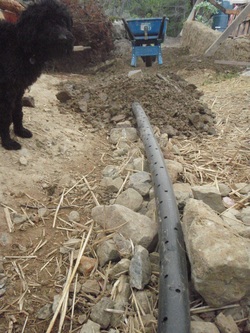 The heavy rains at the beginning of November highlighted the need to add some more drainage to the Main House site. To the left, Willy Willow is inspecting the 2" poly pipe to ensure that enough holes were drilled in to let the water seep in the top of the pipe and then drain out the end of the pipe. Thankfully the floor had not been built up yet; another few hundred wheelbarrow loads of gravel are still to be hauled! Below, another drainage pipe was slid underneath the two Arbutus trees to allow the ash pit of the Ondol tunnel to drain before the water level could rise high enough to reach the cob foundation walls. Of course, once the roof is in place, with its wide overhang, these drainage issues will likely never reappear, but if they do, we've got the systems now in place...let it rain, let it rain, let it rain!
0 Comments
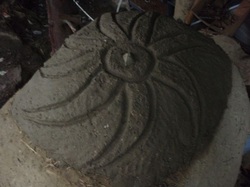 This year's Cob Oven Workshop included a little experiment with some new-to-me natural materials. I had been recently informed about Perlite, a naturally occurring volcanic glass that has excellent insulation properties. We mixed it in a thick clay slip to add to the existing cob oven, which was losing more heat through its top than I wanted. It mixed up very easily and was applied just as easily, holding the shape we wanted. As you can see, it is easily sculpted, too! 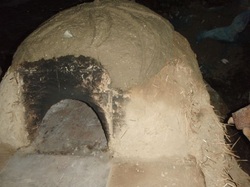 Subsequent tests (well, let's be honest, baking sessions with bread, granola, cakes, cookies and casseroles:) have shown a marked improvement in heat retention and much shorter burn times to heat up the oven in preparation for baking. The first bake took about as long as before applying the perlite/clay topping since it was still not fully dry. But the next bakes used about half the wood and took just over half the time to heat the oven to temperature. Each baking session included a first round of bread and a casserole, then a round of granola, Anicca's Chocolate Cake, and carob chip cookies. Total baking time was only an hour and everything was baked to perfection. Next time, we'll put our yogurt inside over night to take advantage of the residual heat.... 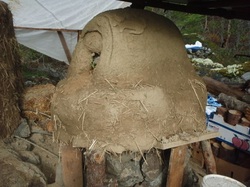 Our last workshop of the year was scheduled for the last weekend in September, usually a dry and calm time of the year. Not so this year; climate change definitely put some unexpected excitement into our Cob Oven workshop! Thankfully, all 7 participants were resilient and ready for the inclement weather. The tarp held and our mixing area did NOT become a mud bowl even though the rain and wind rarely relented throughout the Friday and Saturday. As you can see, we completed a gorgeous Cob Oven, complete with a sleeping clay kittie on top and an arching, decorative rock design around the door. 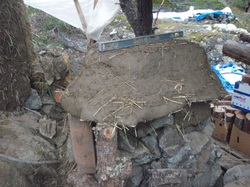 The photo to the right shows the oven after the first day. The oven bricks are about to be laid on top of a thin layer of cob that covers 99 (empty) bottles of beer. This insulating layer keeps the heat where we want it: in and near the oven; and it reduces the amount of time and wood needed to get it ready for baking. 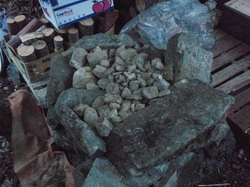 To the left, you can see how we built the oven foundation. Instead of using all large stones, we built a rock circle and filled the middle with smaller stones, greatly simplifying the process. We also decided to build the oven bigger than this foundation would have suggested, so we cantilevered the cob out over the foundation (with the use of wire racks from dead fridges in the local dump) to provide some useful shelving for the hot items coming in and out of the oven. Not recommended, but again, Cob comes through with its flexibility and adaptability, even in the worst of weather! And then there was bread...and more bread...and croissants, and... 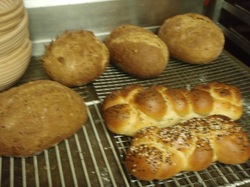 Our baking day at Nadine's was simply stuffed full: full of great instruction, food in our belly's, and fun for everyone. Seeing an expert use a cob oven firsthand increased my use and skill enormously. The incredible list of recipes we received would inspire even the most hardened of bakers. Eating a hand-rolled and topped mini pizza hot out of the cob oven was a delight not many will forget. The amount of breads we took away could have stocked a small store! The amount of bagels and croissants we ate kept us energized for the entire day, despite the non-stop baking action. Thank you Nadine for sharing your gifts, skills and passion. Truly a day that won't be forgotten by any of our cobbers! 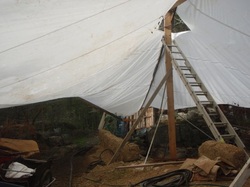 Despite the rip, the great white tarp is holding up! The end of September brought two vicious storms in the course of only 1 weekend, so the prospects of keeping the tarp up and the building site dry for the entire winter didn't look good. But the hole in the top of the tarp seems so actually be helping! The wind now has a place to escape and building a frame completely around the edge of the tarp at least 4' off of the ground has both stabilized it and allowed the wind to exit. The trees on the edge of the building site have been strategically used to attach the frame which dramatically reduces tarp movement, the key to tarp longevity. This tarp is 40' x 60' so it acts like a giant sail. Thankfully the masts in the photo have not taken to the skies as yet, although they do creak when a strong south-easterly blows in. Another stabilizer seems to be the fish nets that we draped over the windiest side of the tarp. They give a bit but definitely help keep the tarp down in even the strongest wind (to date;). It ain't pretty but so far, so dry for all the walls and the tunnel, which is all we hope for. 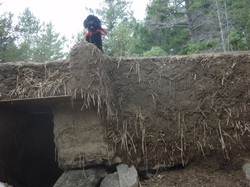 Our resident SuperDog, Willy Willow is proudly perched above the Ondol tunnel opening. If the rainy season weren't fast approaching, she would be sitting beside the double glass doors of the kitchen entrance/garden exit. Below Willy is the 1/4" metal sheet that serves two purposes: it spans the tunnel opening for the foundational wall above it, and it sticks out from the foundation for use as a cooking surface. Instead of building the foundation walls only from rock, we chose to put one course of rock on the bedrock we are building on. To further minimize the amount of rock needed (we haul it in by wheelbarrow - if we can get it in the barrow - or roll it downhill if at all possible), we only built with rock where water could possibly reach (from a spill inside the kitchen or through the Ondol tunnel). During our last two week-long workshops, we built 18" wide cob walls to bring the foundation all up to grade; this will be a great test to see how any rainwater that gets in runs through the site during the rainy season! |
Our Cob Village
We'll try to keep you updated on all the latest activity here at Lasqueti's Cob Village... Categories
All
Archives
March 2019
|

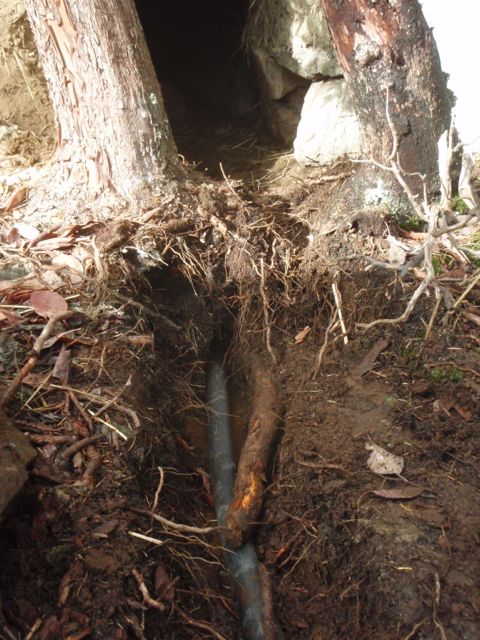
 RSS Feed
RSS Feed
